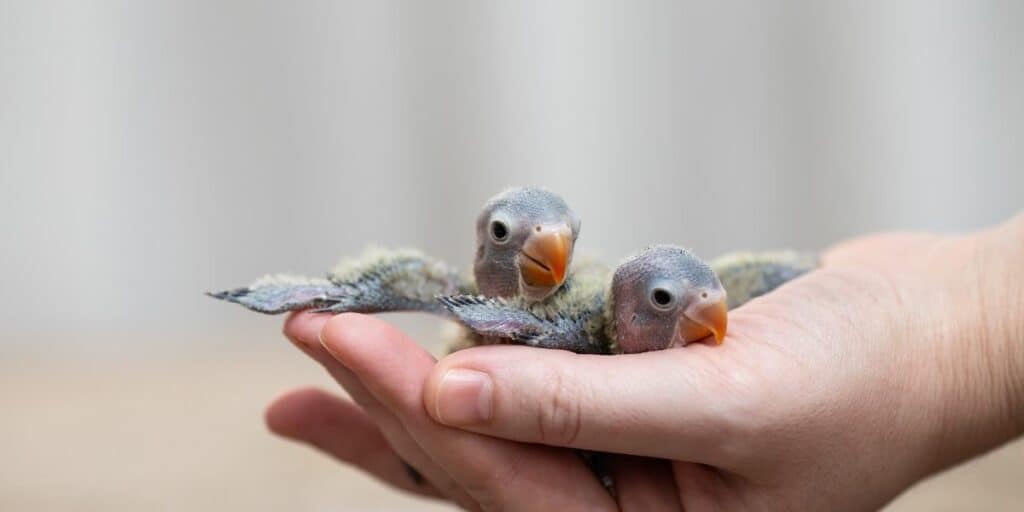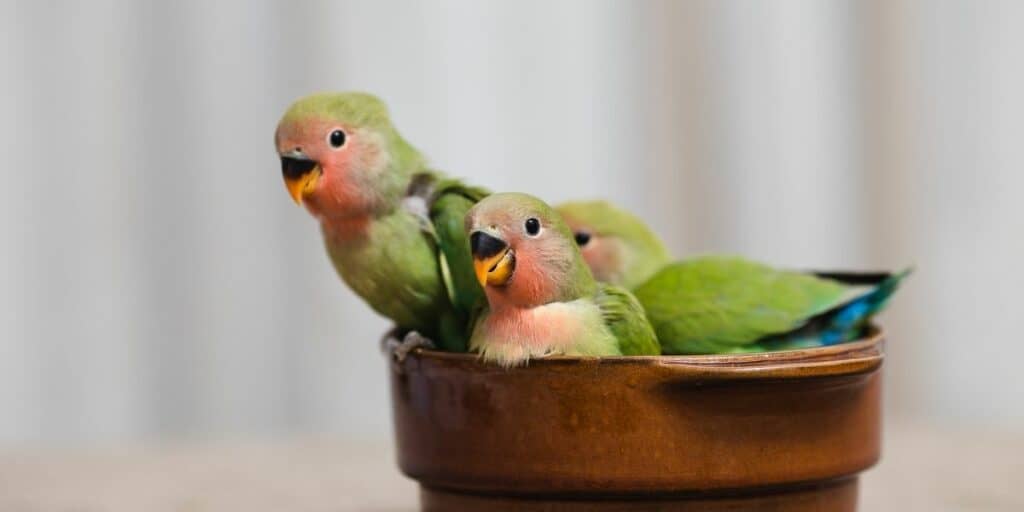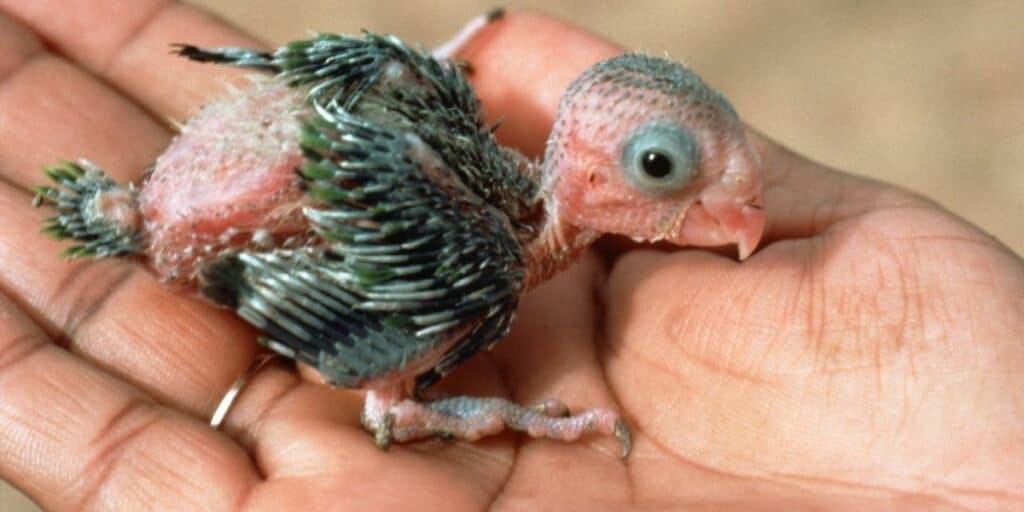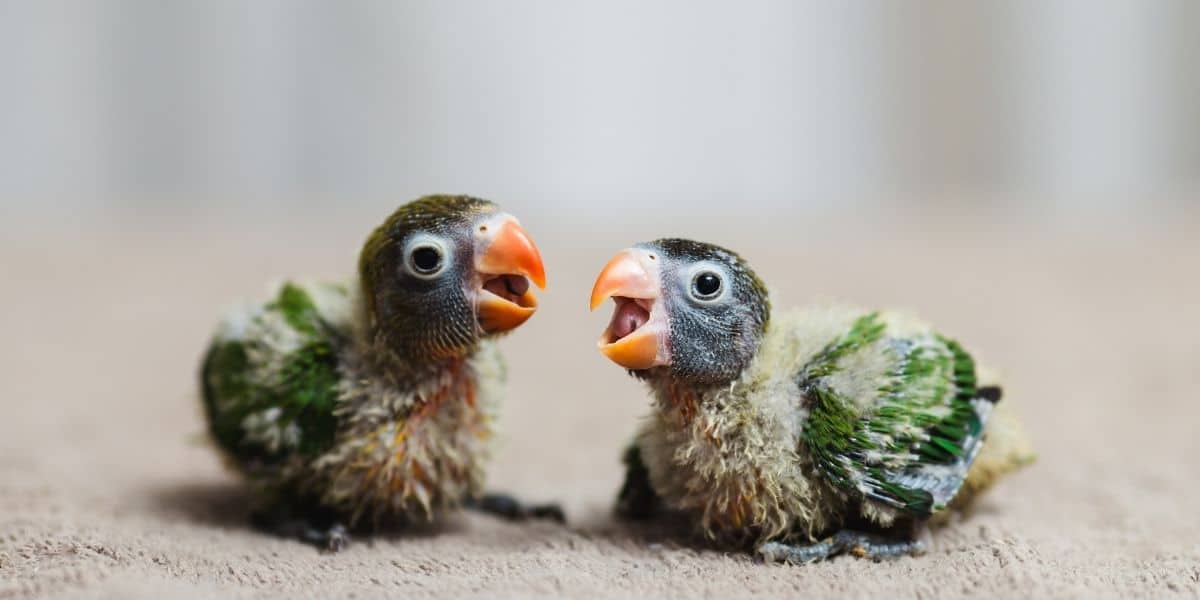Perhaps you are looking to breed parrots or have just received a juvenile parrot to keep as a pet.
Whatever the reason, familiarity with how to raise and care for a baby parrot will ensure success in raising a parrot that thrives.
In this concise guide, we will provide an overview of the techniques, pitfalls, and day-to-day tasks required for looking after parrot chicks just as well as the best breeders.
Table of Contents
There are lots of reasons you might find yourself with a parrot chick to raise
The breeding time for parrots can be extremely difficult for adult birds and the demands placed on both males and females can be too great for them leading to an untimely demise.
A male parrot can die from the exhaustion of feeding a brood and if stressed may attack a female or mutilate chicks. For this reason, breeders are adept at incubating, hatching, and separating chicks to a brooder at the first sign of trouble.
Therefore breeders have developed the skills needed for hand-rearing chicks that are born blind and hairless and assisting them in gaining the best possible start in life.
As they will be completely dependent on you, you need to stay the course on rearing or you will suffer losses.

Housing parrot chicks well: the Psittacine brooder
A brooder is simply a warm, temperature-regulated, and enclosed accommodation for newly hatched birds. Like incubators, brooders can be homemade and have no specific design.
The chicks need to be moved to the brooder before the third week of life so that they have the best opportunity to adapt.
A small box with paper towels on the bottom and ventilation holes will do if the temperature can be maintained. Very young parrot chicks can be placed individually in bedding-lined yogurt pots within the brooder.
One clutch should be housed together and the birds should not mix with other birds to prevent disease.
Keeping parrot chicks warm
Safety is key especially when it comes to heating. Heating pads can burn the chicks or leave some of the chicks cold, therefore a thermostat and regular checks are vital to ensure their wellbeing.
Parrot chicks need a temperature range of 78 to 82 degrees Fahrenheit (25.5 to 27.7 degrees Celsius) from an initial 96 to 98 degrees Fahrenheit (35.5 to 36.6 degrees Celsius) for the first few days after hatching.
Suitable bedding for baby parrots
Paper towel bedding will need to be changed to wood shavings at around 3 weeks of life so their developing feet are properly supported and do not splay.
The bedding should be changed every time a baby parrot is fed. Towels also can be used but these will require regular changes.

Humidity is welcome
High humidity is advantageous to the growth of the parrot chicks as it mimics the best environment in the wild. This may be difficult to achieve in the brooder.
But using water containers for heating or a saltwater bath can provide an appreciable rise in humidity.
Hand-feeding your parrot chick
Once baby parrots are removed from their parents they will be reliant on hand-feeding for at least 5 months. Getting this right is critical to their survival and you are likely to lose parrot chicks that do not establish feeding promptly.
Hand-feeding is also advantageous as it tends to produce tamer birds.
Initially, the baby parrots may be unsettled in a new brooder and will refuse feeds, but if feeding is delayed for up to 12 hours they will accept the food because of hunger.
Hygiene is critical!
These parrot babies have little to no immune defenses against a wide range of germs in their environment.
Unsanitary handling or mixing the birds with older birds or parent-fed siblings will soon lead to disease. They should be handled and moved as little as possible.
Your hands should be thoroughly washed and disinfected before handling the chicks. Latex gloves can be worn. Always set the babies on a clean paper towel after handling.
What to feed a baby parrot
Parrot chicks are typically fed a dry mash formula feed that is mixed up fresh for each feeding. Making fresh batches minimizes any hygiene risks from storing food.
Formular must be accurately weighed and the volume of water used precisely measured. All utensils used should be cleaned and sterilized and the formula well mixed.
The formula mixture is heated to cook and fed to the parrot chick at a temperature of around 100 degrees Fahrenheit (40 degrees Celsius).
Like human baby formula, it should be sired and checked for hotspots. Keep it warm by setting the feeding syringes in a cup of hot water.
The consistency of the parrot baby formula varies with age
First feeds for baby parrots need to be kept relatively thin with no more than 10% of the volume fed being solids. At these tender stages, between days two and four, they are unable to cope with a rich diet and can be upset by too high a concentration of fats and carbohydrates.
As the chicks grow they can have up to 30% solids, described as a consistency that is slightly less thick than applesauce.

Feeding your baby parrots by hand
There are several techniques that you can use to feed your baby bird. Thankfully they make it easy for you as they have a reflex feeding response when the beak is touched.
- A bent teaspoon – this is probably the most time-consuming method and carries a great risk of transmitting germs, but the increased handling and contact does produce a tamer pet.
- Pipette feeding – small pipettes are used with very young chicks, but can only hold a few milliliters of feed at a time.
- Catheter-tipped syringes – this is perhaps a more widely used method as the syringe can be used to accurately measure and dispense the feed in a controlled manner.
- A rubber tube on the syringe – this is used for a far more invasive form of feeding and requires experience or veterinary input. Once a parrot chick is fed in this way it will take longer to wean them.
The objective of hand-feeding baby parrots is to fill the parrot’s crop. The crop should not be overfilled or distended with food and should be allowed to empty before the next feed. Feeds are usually at a frequency of 6 times per day with thinner feed, reducing to 4 times per day with thicker feeds.
Identifying your baby parrots
If you are raising a hatched clutch of eggs and need to identify the individual bird to track growth or follow their lineage, you will need to apply closed leg bands to their feet.
This is a simple task snd does not hurt the parrot. These bands should be applied between two and three weeks of age by placing the front large toes through the band and sliding the band over the smaller inside toe at the back of the chick’s foot.

Charting the growth and condition of a baby parrot
Tracking the growth of your baby bird is critical to ensuring that they are thriving and spotting problems early. Take daily weights in the morning, before the first feed when the parrot chick is completely empty.
Also, observe closely the development of the parrot chick, paying attention to the following areas:
- Plumpness: a well-fed and hydrated bird will have good skin tone and pert flesh.
- Skin color: expect a healthy flesh color in a well bird, pallor and mottling are bad signs.
- Skin texture: a dehydrated bird will have crispy, wrinkly skin.
- Body symmetry: poor growth may lead to shrunken feet and wings with the head looking overly large.
Ready to wean your baby parrot?
Weaning is influenced by several factors including weight, development of the wings, and the transition to a cage.
The young parrots often lose weight in this process; weight loss of more than 15% is considered abnormal and should be investigated.
Feeds are increasingly thickened and no longer delivered via syringe, but rather offered on a spoon for the juvenile parrot to peck at.
The thick lumpy food is eventually left in a bowl at the bottom of the cage for feeding times.
Common health problems in young parrots that you need to look out for
Here are some health problems that are frequently encountered in the raising of parrot babies. Consult your vet immediately if you encounter any of these problems so that the parrot chick can get the treatment and support it needs.
- Infections: Hand rearing and feeding carry a high risk of digestive tract infection. The process is clearly artificial and the young are deprived of the normal protective microbial flora that they would enjoy in the nest. Key infections in hand-fed baby parrots include:
- E.coli
- Klebsiella
- Pseudomonas
- Candida
- Crop stasis: This condition is caused by food remaining in the crop too long and causing a fungal infection. A common cause of this is that the formula dries out in the crop. It is usually treated by adding warm water to the crop and gentle massage to move the lump on. It can also be caused by the baby parrot eating bedding material which becomes impacted in the crop.
- Crop burn: Be very careful with the temperature of the warmed feeds as they can cause a scald of the crops. Mix feeds well and double-check the temperature. Any food that is above 41 degrees Celcius will burn the parrot baby.
- Toe constriction: Sudden episodes of severe dehydration can lead to skin cracking and the formation of a fibrous band of tissue around the big toe of the baby parrot that can cut the toe’s blood supply.
- Aspirated feeds: This is a complication of formula feeding and involves the feed going down the wrong way.
- Beak deformities: Macaws that are fed improperly are vulnerable to abnormal development of the beak.
In conclusion
Being able to raise and care for a baby parrot is a great achievement and will require high levels of responsibility and commitment to the task.
Before you dive into this important endeavor, we encourage you to do further research on how to best raise baby parrots. We heartily recommend these online resources:
Also, reach out to local breeders who may be able to demonstrate some of the techniques discussed and give great advice and encouragement.




